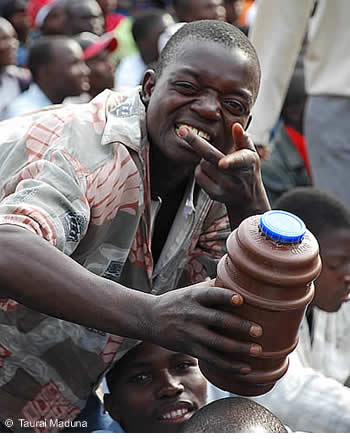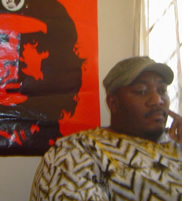An essay entitled Beyond Mandela by Onyekachi Wambu caught my eye today and it reminded me of a quote that we included in a recently published Kubatana electronic newsletter. Michelle Gavin, an international affairs fellow at the U.S.-based Council on Foreign Relations suggests that it is necessary to avoid the trap of embracing “an anyone-but-Mugabe approach while the system stays the same”. She recommended an emphasis on better governance – adherence to the rule of law, an end to political violence, and free and fair elections.
As we approach yet another election how are we, the citizens of Zimbabwe, investigating, analyzing, debating and reviewing what the political opposition stands for? If we don’t snap out of this “anyone but Mugabe” mode it is almost certain that we will, if a free and fair election takes place (very doubtful), be voting in a new government with the same corrupt and flawed systems in place. As Onyekachi Wambu states in the context of South Africa, and the same applies to Zimbabwe, “we require a partnership between leader and led, where there is genuine two-way communication and accountability as we move to deliver on the promises of liberation – peace, safety, economic prosperity and dignity.”
Below is the full text of Wambu’s essay
Last weekend I drove through Parliament Square to catch my first glimpse of the Nelson Mandela statue. As I drew closer to the monument, which was smaller than I expected, I saw a black family sitting at the foot of the outstretched arms, having their picture taken. Mother, daughter, father – drawn to the square, to Nelson.
Two days later I was passing again, on a bus. The scene was repeated: another black family, in Mandela’s embrace, pride on their faces. Nelson, drawing black people into this public space, his healing magic melting away years of exclusion and bitterness, redefining the meaning of the square for us. In time, might we even begin to speak of Nelson’s Square?
There is a reason to cheer – but cheer what, exactly? What does his statue symbolise for the black families who will visit? Some, including the great man himself, have spoken about it representing freedom and liberation. But this is too simple in a way, neatly packaging a messy period, and one with consequences that have yet to unravel.
But in discussions about black leadership some of my friends and colleagues have over the years voiced great hostility to Mandela, believing he was lauded by the west because he sold out on the key issues of land and the economy – and nobody ended up in The Hague for crimes committed under apartheid. For them, the statue might then encapsulate this story of betrayal, from the idealised clarity of militant imprisonment to the later, post-prison compromise.
Even if one accepts the underlying sentiment of such an analysis regarding the deal struck, on a human level it overlooks any appreciation of the suffering endured by Mandela and the generation who spent decades in prison. His detractors seem to demand even more sacrifice – like their martyred heroes Steve Biko or Patrice Lumumba – rather than the gentle denouement of honourable retirement. The heavy burden of black leadership was suddenly immediate and sobering.
Looking at the range of post-independence African leaders, the common perception has been of corrupt and venal individuals, brutal dictators and tyrants, and sit-tight presidents for life – very few of whom have improved the lot of their people. Like all stereotypes, it captures an element of truth, but the reality is more complex. Later this month Mo Ibrahim, one of the continent’s richest men, after assessing the performance of the continent’s leaders in a sort of beauty contest, will offer the “winner” $5m – effectively a bribe to persuade them to do the right thing.
In this year of commemoration of the abolition of the slave trade, I hope the statue and Ibrahim’s award will enable us to open a dialogue about black leadership. After all, Mandela and his Robben Island colleagues evoke another great generation from an earlier period on San Domingo, in the Caribbean, who secured the first victory against slavery, constitutional racism and white dictatorship. Toussaint L’Ouverture, the great conciliator and leader of that group of liberators, had been imprisoned by Napoleon Bonaparte, who betrayed his own promises to L’Ouverture as well as the ideals of the French revolution. As the struggle for liberation continued, L’Ouverture was replaced by the uncompromising Jean-Jacques Dessalines, who massacred whites on the island on the way to establishing an independent and free state, Haiti.
Two hundred years later, Mandela would forgive white South Africa. We are now in the post-liberation phase, and the quest for development is now the measure of the leadership needed from Africans.
Ali Mazrui, one of the contributors to a book on African leadership I have edited, rightly points out that over this 200-year period, people of African descent have produced an extraordinary number of leaders of liberation and conciliation, but have been poor in producing effective leaders of development – something the Ibrahim “beauty” index should address. I don’t believe these leaders of development need be Moses figures.
We require a partnership between leader and led, where there is genuine two-way communication and accountability as we move to deliver on the promises of liberation – peace, safety, economic prosperity and dignity. In the end, finally looking up into those outstretched arms, I was glad the statue of Nelson was not that big, that it had human proportions. After all, it is in our hearts that men become mountains.




 Across Zimbabwe,
Across Zimbabwe, 







